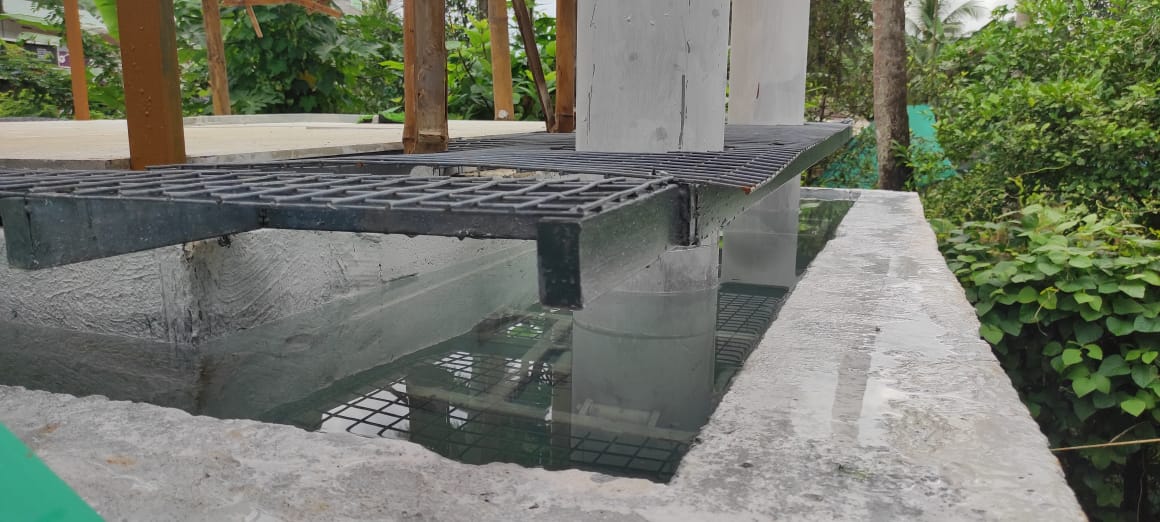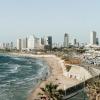Amphi Nest, India's first flood-resilient amphibious pavilion prototype
Kerala Floods and Amphibious Buildings
Kerala, a southern tropical state in India with a population of over 33 million, is globally recognized for its impressive achievements in human development. However, Kerala is highly vulnerable to natural disasters and changing climatic dynamics, given its location along the sea coast and steep gradient along the slopes of the Western Ghats. Kerala is also one of the most densely populated Indian states (860 persons per square kilometer) making it more vulnerable to damages and losses during disasters. Floods are the most common natural hazard in the state. Nearly 14.5% of the land area of Kerala is prone to floods. In 2018, the flood affected 5.4 million people (including 2 million children) and 1,259 villages in the state. There was a point when more than 1.45 million people were displaced and living in the relief camps. (Source: Kerala Post Disaster Needs Assessment 2018)
Amphibious houses are houses that will survive normal dry conditions and also during floods. These houses, made of concrete hollow box-like structures or concrete with EPS (expandable polystyrene) blocks, will temporarily float during floods. It rises up and down through guidance posts which hold the house in position.

In 2017, Nanma Gireesh conducted research about flood-resilient amphibious (temporary floating) houses. A year after in 2018, along with her colleague Ben K George, she co-founded an interdisciplinary consultancy firm called NestAbide. Along with a small team, Nanma, a civil engineer, and Ben, an electrical engineer, started working on the implementation of amphibious houses considering vernacular architecture and materials in Kerala.
Amphi Nest, the amphibious building prototype
In 2021, they built India's first amphibious pavilion structure, a working prototype, to show how an amphibious building stays on land like any conventional home and floats when the floodwaters arrive. Named ‘Amphi Nest', the structure is built to set an example of a flood-resilient construction technique where people can continue their usual living style without compromising much. The house will save itself during a flood. It is space for living and also space for water!
The prototype pavilion of 200 sq. ft area, including the space inside the concrete-hollow box, is estimated about INR 3,00,000 (3700 EURO) to build. It was designed for a capacity of a maximum of 10 people at a time onboard. The Buoyant Foundation, weighing about 9 tonnes, is a concrete-hollow box reinforced with a layer of steel reinforcement and wire mesh. There are four numbers of Guidance Posts (GP), also known as Dolphins, with a diameter of 20 cm filled with concrete and steel reinforcement. The GPs are connected to the foundation using roller fenders. A wet dock using reinforced concrete is designed to withstand water pressure. It is built to simulate flood conditions and demonstrate the working of the prototype. During the construction of a home, a wet dock may or may not be built, and it depends on the soil and water characteristics of the selected site. If needed, it will only be built below the ground level using porous concrete for the water to penetrate into the earth.

Flexible utility lines are provided, including electrical connections to light up the pavilion during the night. Solar-powered lights are also installed to show people the different options and alternatives. Flexible water lines are connected to pump water in and out of the wet dock to demonstrate the working. Bamboo decors are given as walls beneath a roof made of polycarbonate sheet on a GI (Galvanised Iron) square pipe framework.

'Amphi Nest' was inaugurated on 4th September 2021 by Mr. P. Prasad, Minister for Agriculture, among other delegates of the State Government of Kerala. Mr. P. Prasad was Chairman of the Housing Board during the floods in 2018. During his inaugural address, he pointed out the importance of flood resilience, adaptation and amphibious buildings. He quoted that we are not living in a safe zone. The changes in monsoon patterns and characteristics indicate the effects of climate change. We need to adapt. The prototype was dedicated to society, especially the flood-affected people in Kerala. It situates near State Highway (SH1) and the upcoming Kerala Science City in the Kottayam District of Kerala, which ensures visibility.
Impact in Kerala, India
The prototype quickly gained the attention of the Government as well as private land-owners of Kerala. Currently, three amphibious housing projects are ongoing in Kerala, among several others in discussion. Two of the houses are for selected beneficiaries from flood-prone regions of Kuttanadu and Munroe Islands of Kerala. The project is funded and supported by KDISC (Kerala Development Innovation and Strategic Council) and the Government of Kerala. The privately owned residential project is for a person who owns a plot near Meenachil River, one among the 44 rivers in Kerala.
In 2022, the co-founders of NestAbide, Nanma and Ben, were recognized by Forbes 30 Under 30 Asia in the sector of Industry, Manufacturing and Energy for realising the ‘Amphi Nest’ prototype in India. They are managing NestAbide as well as simultaneously working on their PhD research on floating and amphibious developments at the Delft University of Technology, the Netherlands.
The true mission of NestAbide is to promote amphibious living; living with the water, instead of fighting against it.
About NestAbide
NestAbide is an interdisciplinary firm working on eco-technologies and nature-based solutions like Floating Wetlands and Zonal Wetlands, Flood Modelling and GIS - Geographic Information System and Amphibious - Floating buildings for people to be safe during and after a flood event. NestAbide is the only firm in India primarily focusing on amphibious housing, resilient and adaptation technologies for people, the planet and also for profit to sustain entrepreneurship. The team hopes to build flood-resilient communities and floating cities to help people adapt to the near future. NestAbide is also an architectural and structural design consultancy firm based in Trivandrum and Kottayam of Kerala with interdisciplinary engineers, architects, science graduates etc.






Trending Discussions
From around the site...
“Absolutely interested! I'll connect via email to discuss reviewing and enhancing the Economic Analysis of Climate...”
Adaptation-related events at COP28 (all available to follow/stream online)
“Please check out these adaptation-related events taking place at COP28 - all available online (some in person too if...”
Shining a light for biodiversity – four perspectives to the life that sustains us. Four hybrid sessions.
“30 November to 19 December 2023 - Four Sessions Introduction The SDC Cluster Green is happy to invite you to the...”